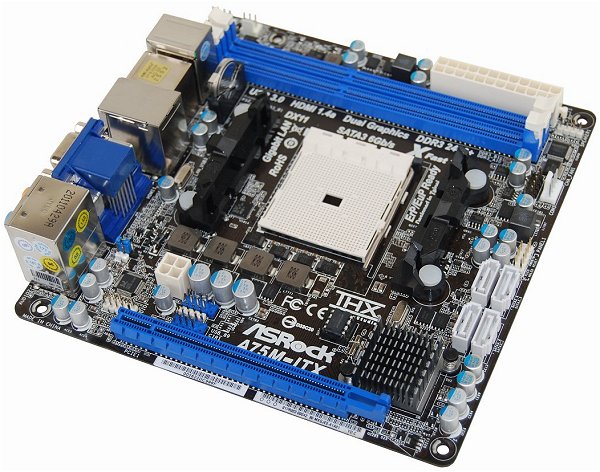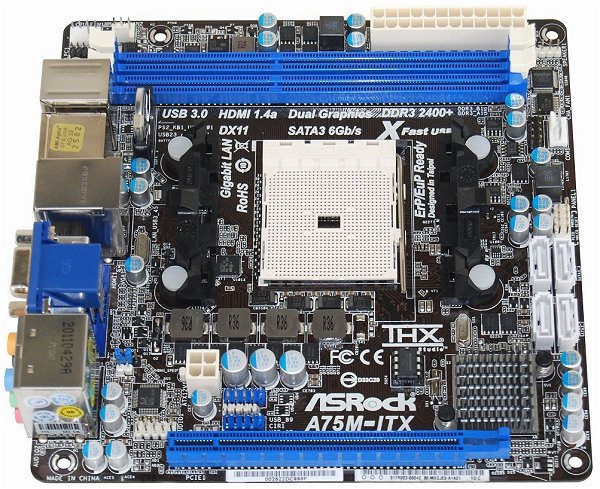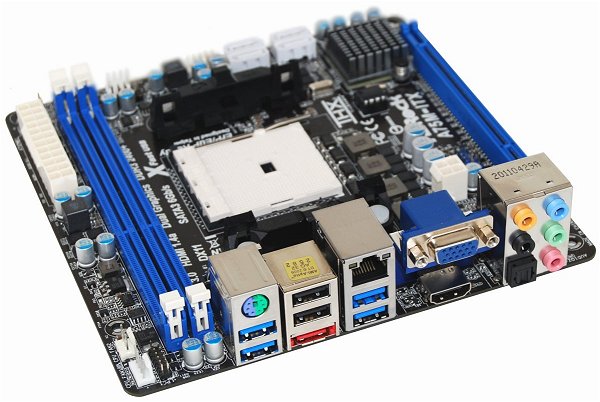Asrock A75M-ITX
Like its Intel-based counterpart, the A75M-ITX is a Mini-ITX motherboard that measures 6.7 x 6.7 inches (17 x 17 cm), and it's also equipped with a new chipset. Because AMD's A75 FCH (Fusion Controller Hub – codenamed Hudson-D3) provides many of the essential features, Asrock hasn't had to litter the board with third-party chips.

The board features two DIMM slots, a PCIe x16 slot, four SATA ports, eSATA, USB 3.0, 8-channel audio, and Gigabit LAN. That list may seem barren, but many standard ATX motherboards in the same price range don't offer much more.
The dual-channel DDR3 DIMM slots support 1066/1333MHz memory, while 1600MHz, 1866MHz and 2400+ is supposedly supported via overclocking. Again, Asrock advertises a maximum memory capacity of 16GB, but that would require two 8GB sticks and they aren't easy to come across (Newegg had one in stock as of writing).


The Hudson-D3 can handle up to six SATA 6Gb/s ports, but this product only has four onboard ports as well as one eSATA connector at these speeds. In other words, Asrock has chosen to ignore the A75's sixth SATA port.
Unsurprisingly, this board has the Realtek ALC892 audio codec, which supports Blu-ray and THX TruStudio Pro audio. Again, this is a commonly used solution, particularly by Asrock and we haven't had any problems with it.

Whereas the Z68M-ITX/HT used the ASMedia ASM1042 for a pair of USB 3.0 ports, the A75M-ITX has the luxury of native USB 3.0 support. The A75 chipset provides four USB 3.0 ports – twice the connectors sans third party chips.
Like the Z68 board, the A75M-ITX uses Realtek's RTL8111E for network functionality. This controller supports Wake-On-LAN, LAN Cable Detection, Energy Efficient Ethernet 802.3az and PXE (Pre-Boot Execution Environment).

As mentioned, the A75M-ITX offers a full speed PCI Express 2.0 x16 slot, which can accommodate most current graphics cards.

The AMD A75 chipset is passively cooled by a tiny silver heatsink, which is near the vertically aligned SATA ports. The 24-pin ATX power connector is mounted at the top of the board and below that are two DIMM slots. Admittedly, this is an unusual configuration but it worked well nonetheless.

The I/O panel features a PS/2 port, VGA and HDMI outputs, eSATA, two USB 2.0 and four USB 3.0 ports, gigabit Ethernet, five audio jacks and an optical SPDIF port.
